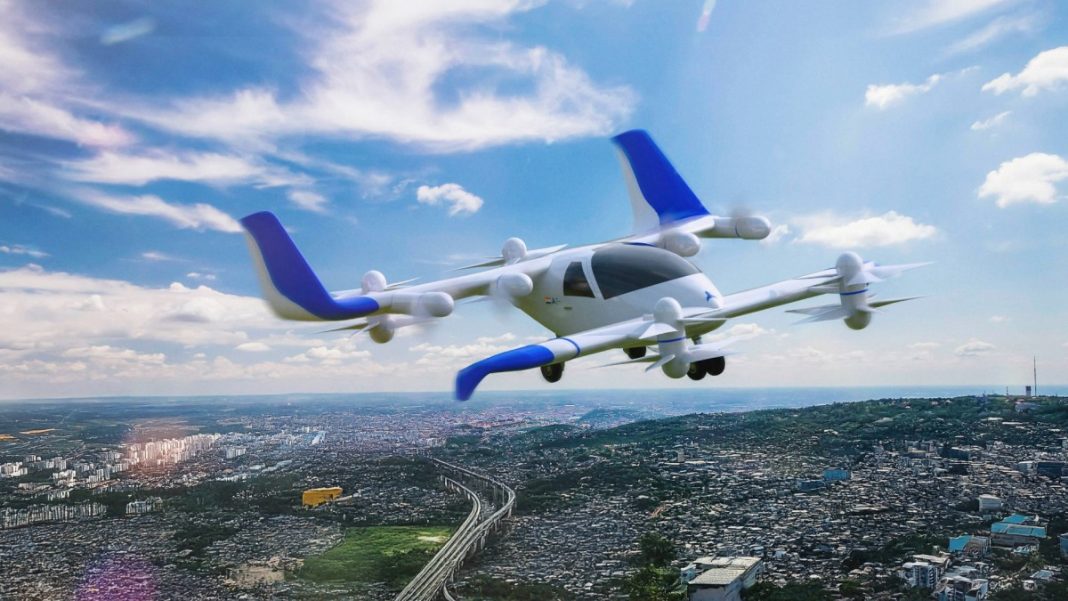Soaring private vehicle ownership and declining use of public and nonmotorized transport have created mounting traffic congestion in India, the world’s most populous country, which also struggles with relatively narrower roads and inadequate parking facilities in cities. New Delhi recognizes these challenges and has been exploring new ways to address them quickly.
Indian prime minister Narendra Modi, at an event in September, said that air taxis will soon be a “reality in India,” indicating the government’s interest in supporting the new transportation mode. The country’s aviation regulator, the Directorate General of Civil Aviation, also recently framed rules for vertiports to set the ground for air taxis.
The ePlane Company is riding this wave.
The startup, founded by IIT Madras aerospace engineering professor Satya Chakravarthy in 2019, is building its electric vertical takeoff and landing (eVTOL) vehicle, the e200x, several months after developing unmanned drones for cargo and camera applications. Chakravarthy has a strong pedigree: He is also a co-founder and adviser at Indian space tech startups, including Agnikul and GalaxEye, and at an Indian hyperloop-focused startup, TuTr Hyperloop.
Chakravarthy told TechCrunch that ePlane secured IPs in developing the intra-city commute and cargo-focused aircraft with reasonably slow fly speed and a compact wingspan of 8 meters, unlike typical air taxis with 12- to 16-meter wingspans. That will enable it to land in tighter spaces and make multiple short trips — up to 60 trips a day — on a single charge, he says. Commuters would reduce travel time by as much as 85%, at a cost of less than two times the fare they usually pay on an Uber ride, he claims.

Most eVTOL vehicles currently are multicopters similar to commercial drones, including air taxis carrying spokes and vertical rotors. Chakravarthy said that while this configuration is easier to develop and implement in the market, it does not cover longer distances with a single battery charge. ePlane chose a lift-plus-cruise configuration where the vehicle carries a winged architecture just like a typical plane but with vertical rotors similar to a drone.
“This configuration has been proven to actually be very reliable because we have redundancies in terms of the vertical rotors carrying the weight of the aircraft, while wings taken with their share of balancing the weight progressively so that we don’t have a loss of lift during the transition from a vertical takeoff and hover to forward flight,” he said.
The startup has also developed technology called synergistic lift, which uses vertical rotors even in forward flight to make wings compact enough.
Chakravarthy told TechCrunch that ePlane manufactures aircraft components at its IIT Madras facility, including airframe parts and designing seats and propellers. The startup outsources cells but assembles batteries for the aircraft at its facility to manage the aircraft’s center of gravity.
The startup aims to commercialize its electric air taxi in the middle to second half of 2026 after securing the required certifications from the Indian and global authorities and prototyping the aircraft in the first half of 2025, Chakravarthy told TechCrunch.
Ahead of testing the vehicle, ePlane has raised a $14 million Series B round co-led by Speciale Invest and Singapore’s Antares Ventures. The all-equity round also included participation from Micelio Mobility, Naval Ravikant, Java Capital, Samarthya Investment Advisors, Redstart (from Naukri), and Anicut. The round has valued the startup at $46 million post-money — over 2x its previous $21 million valuation.
The fresh capital will help ePlane, which has a workforce of over 100 people, secure global regulatory certifications and boost its commercialization efforts.
India’s success would help ePlane enter other markets, including the Middle East, Southeast Asia, Australia, and Europe.
“We are working with a conviction that going forward, what’s good for India will be good for the world,” Chakravarthy said.
[ad_2]
Source link


